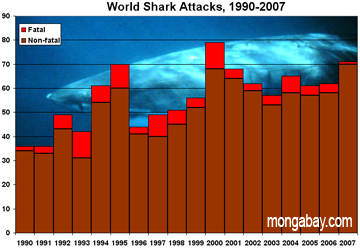Sharks increasingly endangered as finning, overfishing take toll
Sharks increasingly endangered as finning, overfishing take toll
Rhett A. Butler, mongabay.com
February 23, 2007
Scientists added several species of pelagic sharks to IUCN Red List of Threatened Species after research found them to be more endangered than previously thought.
Three species of thresher sharks were listed as Vulnerable globally, while the shortfin mako was upgraded (or downgraded depending on one’s perspective) from Near Threatened in 2000 to Vulnerable and the scalloped hammerhead shark was moved from Near Threatened to Endangered. The decisions are based on work by the IUCN SSC Shark Specialist Group (SSG).
“The qualities of pelagic sharks — fast, powerful, wide ranging — too often lead to a misperception that they are resilient to fishing pressure,” said Sarah Fowler, Co-Chair of the IUCN SSC Shark Specialist Group (SSG). “This week, leading shark scientists from around the world highlighted the vulnerability of these species to overfishing and concluded that several species are now Threatened with extinction on a global scale.”
IUCN states that there are many threats to sharks today.

While most people think of sharks as dangerous animals, shark attacks are exceedingly rare. The annual survey of shark attacks, released two weeks ago, showed that it is far more likely to be killed by a falling coconut than a shark. Globally, four people were killed in unprovoked shark attacks in 2006. |
“Pelagic sharks are taken incidentally in high seas tuna and swordfish fisheries, and increasingly targeted as new markets for their meat develop and demand for their valuable fins grows,” explained in a release. “Bans on shark “finning” — slicing off a shark’s valuable fins — have been adopted for most international waters, but lenient standards and lacking enforcement hamper their effectiveness.”
“Despite mounting threats and evidence of decline, there are no international catch limits for pelagic sharks,” said Sonja Fordham, Deputy Chair of the SSG and Policy Director for the Shark Alliance. “The workshop results underscore the urgent need for international fishery commissions to limit fishing for these vulnerable species and strengthen regulations on the wasteful practice of finning.”
Research published last year in the journal Ecology Letters estimated that 26 million to 73 million sharks are killed each year for their fins, a number three times higher than those projected by the United Nations. Shark fin is a popular delicacy in Asia — especially China, where it is typically served in shark fin soup weddings, business dinners, and other celebrations. Shark fin soup can fetch up to $120 per bowl. Fins are usually sliced off as the shark, often while still alive, which is then thrown back into the ocean. Research published in the December 5th issue of the journal Current Biology said that overfishing is causing a population collapse on Australia’s Barrier Reef, generally considered one of the world’s healthier marine ecosystems.
IUCN notes that sharks are especially susceptible to overfishing because they mature slowly and produce few young.
While IUCN’s report is generally bleak, there was one bright spot. The pelagic stingray was listed as Least Concern due to its “apparently stable, if not increasing trends.” IUCN said the status change was the result of discovering previously unknown populations rather than an actual population increase.
The IUCN Shark Specialist Group is working to assess all 1,200 species of sharks, skates, rays, and chimaeras by the end of 2007
The World Conservation Union is the world’s largest conservation network. It brings together 82 States, 111 government agencies, more than 800 non-governmental organizations (NGOs), and some 10,000 scientists and experts from 181 countries in a worldwide partnership to “conserve the integrity and diversity of nature and to ensure that any use of natural resources is equitable and ecologically sustainable.”
This article contains quotes and information from an IUCN news release.














